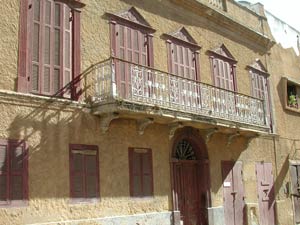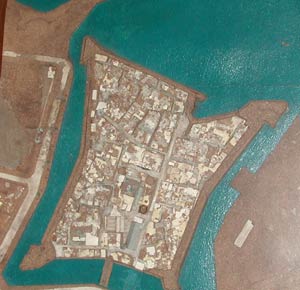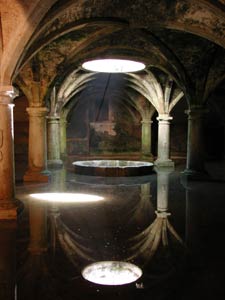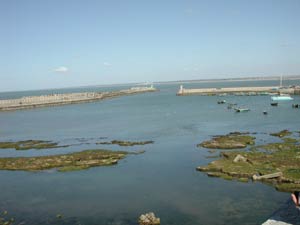Previous:
Azemmour |
Pirate
Coast
El Jedida (Mazagan) |
Next:
Safi |
 In
Leo's days, El Jedida was called Mazagan- the main Portugese port in North
Africa. First discovered by them in 1502, it was fully functional by 1506.
After the fall of Azemmour, Mazagan became the center of all Portuguese
operations in the Atlantic- so precious was this base that they held on
to it until the late 18th century, when it was re-conquered by the Moroccans.
At that time, the city was given it's present name: "El Jedida"-
the "New City", marking a permanent break with its Portuguese
past. In
Leo's days, El Jedida was called Mazagan- the main Portugese port in North
Africa. First discovered by them in 1502, it was fully functional by 1506.
After the fall of Azemmour, Mazagan became the center of all Portuguese
operations in the Atlantic- so precious was this base that they held on
to it until the late 18th century, when it was re-conquered by the Moroccans.
At that time, the city was given it's present name: "El Jedida"-
the "New City", marking a permanent break with its Portuguese
past.
 The
map shows the outline of the Portuguese city, whose main artery used to
be a canal linking the outer waters to downtown- facilitating the transportation
of merchandises to and from the ships. Carefully walled and surrounded
by water, the city was easily defensible, which explains the prolonged
Portuguese presence on the Moroccan coast. The
map shows the outline of the Portuguese city, whose main artery used to
be a canal linking the outer waters to downtown- facilitating the transportation
of merchandises to and from the ships. Carefully walled and surrounded
by water, the city was easily defensible, which explains the prolonged
Portuguese presence on the Moroccan coast.
In
addition, Mazagan's naturally calm waters (the calmest along the Atlantic
coast) made for the ideal port. Two jetties creating an artificial cove
added to this calmness- a perfect harbor for merchant galleys (see below).
At
a time when many of the Portuguese enclaves in North Africa were being
re-conquered by the Saadian princes, Mazagan was a safe harbor for merchants
wanting to trade 'Caravan goods' (click
here for more on Caravans).
 To
protect the city from all attacks and sieges, the Portuguese built a cistern-which
could contain up to 4 million liters; enough water for 5000 people during
2 months! A complex system of gutters and terraces funneled all rain water
into this vaulted cellar- at its center, an opening served as well, letting
locals draw water from the cistern. To
protect the city from all attacks and sieges, the Portuguese built a cistern-which
could contain up to 4 million liters; enough water for 5000 people during
2 months! A complex system of gutters and terraces funneled all rain water
into this vaulted cellar- at its center, an opening served as well, letting
locals draw water from the cistern.
Today
the cistern is no longer in use- and they keep just enough water in its
center for charmed tourists to take pictures of reflections of light and
columns.

|